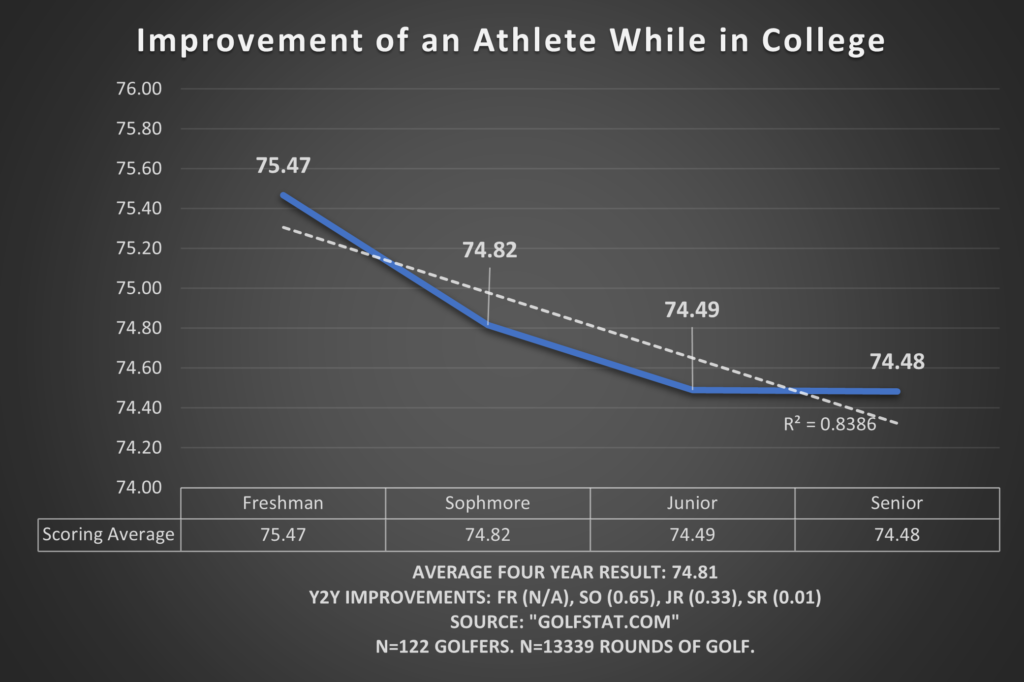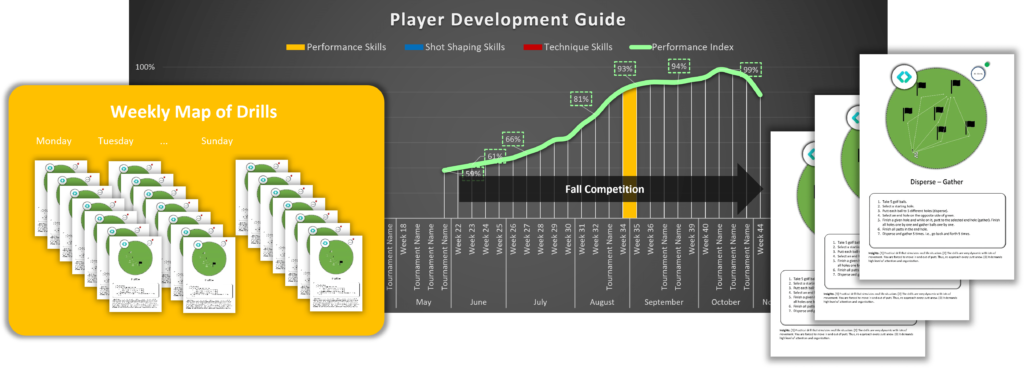
Introduction.
Years after graduating (2021) from Seattle University as NCAA DI Golf Team Captain (2015), and once admitted to the PGA of Croatia (2020), I (Luka Karaula) wanted to know how much do student athletes improve during four years of college golf. As years passed by I sensed there is a huge untapped potential for college golfers to improve from Freshman to Senior year – I wanted to investigate.
Let’s jump to research findings right away, explore possible root causes that are potentially causing stagnation in players/teams growth, address them and mention ways in which to go about improving individual and team scores long term.
Research Finds: Average College Golfer Improves by 0.99 Shots During College.

Data on 13,000+ NCAA DI rounds from 122 golfers (source golfstat.com) shows that on average, from Sophmore to Senior year, college golfers (men) improve by 0.99 shots. Most significant improvement happens during Sophomore year which accounts for 0.65 shots. During Junior year and on average, a player improves by 0.33 shots. During Senior year in college, athletes improve by 0.01 shots on average. Average result of a college golfer during college (4 year period) is 74.81 shots per round.
Freshman year improvement is not accounted for in this research – it would demand scores for the year preceeding the first year in college to serve as a comparison reference point for Freshman year in college.
The following rules were respected as the data was being collected:
- Source: golfstat.com
- Data ranges from year 2000 to 2020
- Golf teams and players were selected arbitrarily
- Only male golfers
- Only players who have played all 4 years of college for the same school
- Only players who have played at least 15 rounds of golf per season (minimum 60 tournament rounds during 4 year tenure. On average, players in the dataset played 109.6 rounds in 4 years.)
An Excerpt from the Dataset:

- Number of competitive rounds during college
- Freshman year average score
- Sophmore year average score
- Junior year average score
- Senior year average score
- Average total score during 4 year period
Possible Root Causes and Pain Points Behind Poor Improvement Rate.
By the nature of college (organized team) golf, schedules of both players and the coaches are filled with activities and leave little to no time for purposeful preparation, guided team efforts nor detailing. This setup breathes any or all of the following pain points, scenarios and root causes that might be present in the team:
Hard Root Causes and Pain Points:
Points #1 to #10 are objective hard resource-based root causes that are addressed immediately upon the implementation of the GolfTool.io Conditioning System.

Skills not acquired during practice sessions are skills not utilized during competition.
- No long term practice plan in place. Practice sessions not prepared (planned) ahead of time or are being improvised on the morning of. Practice plan completely absent or no simple nor easy ways/planning tools to prepare all daily/weekly/seasonal practice sessions in advance.
- No long term practice program in place. Relates to point #1 No Practice Plan. No practice program that organizes and connects all daily/weekly/seasonal practice sessions into a meaningful whole.
- No performance skills periodization scheme. Currently, vast majority of teams use gym efforts to bring players to the best physical condition for the competition season (using periodization scheme), while rarily any golf team uses golf skills periodization scheme to bring the players to the best golf game condition during competition season. For example, there is no organization nor structure on a grand scheme of things when it comes to practice sessions. Relates to point #1 No Practice Plan, #2 No Practice Program, and leads to #4.
- No performance forecasting. Generally, amongst golf teams, there is an abscence of a system that predicts top performing weeks and guides players to that time period. It is understood that the competition season demands best golf shape, yet no trustworthy forecast is in place to dictate what exact activities need to be performed at specified dates throughout the season – to build the players golf shape from foundations to advanced skills and lead to best possible scores when it matters the most.
- No resources/golf-education available to the players. Relates to all above points. No access to golf drills, challenges, games, tests, specific exercises, etc. No scientifically backed insights into what exact skills are being developed with each specific activity.
- No team friendly challenging activities that simulate real competition. Relates to point #5 No Resources/Education. Naturally, during practice sessions players (team) generally feel that they have to beat one another, yet during competition they all work for the same goal – beat other teams. What if this discrepancy conjoined? What if players formed competitive groups during practice sessions and preserved a sense of togetherness and support? There are no activities in place during practice sessions that force the entire team to depend on each others performance. No team challenges that makes the team members cheer for one another by default during practice sessions.
- No unified team efforts. Relates to point #3 No Periodization and #4 No Forecasting. Team efforts are scattered most of the time players step on golf premises. Each player works on different area of the game at different parts of the season(s). Each player is either slave to old practice/play habits or is improvising on daily basis, outside of organized team efforts.
- No guided team efforts. Relates to point #3 No Periodization and #4 No Forecasting. Practice/play days are not connected throughout the year. Players for the most part (and the team) function as leafs carried by the wind, they are all over the golf facility without any system that keeps them together nor connects their golfing efforts yesterday to today to tomorrow.
- No simplicity. No intuitive golf. Team lost in AI’s historical details. Limiting beliefs are being formed around accurate statistics. Players true golfing abilities become disillusioned by wide pool of accurate data vs empowered by old-school intuition and forward-looking tech solutions. With emerging technological solutions, the team (players and coaches) becomes overflowed with highly accurate AI based performance oriented information that analyzes past behavior and tries to figure out the player(s) game patterns up until today. AI is entirely about yesterdays shots, as such, its suggestive reach extends no further than today. By the nature of its design, it does not tell what needs improvement the upcoming week, let alone season – this is where to #3 Periodization and #4 Forecasting come into play. This leads players into trusting Artificial Intelligence (i.e. historical data that relies on the past) more than their own natural intelligence (i.e. forward thinking data that relies on intuition and drives players forwards for weeks/months ahead of time) – players minds should be focused on both improving the skills that were off yesterday (i.e. retrospective) and improving the skills necessary for better golf tomorrow (i.e. forward-looking, for weeks/months in advance).
- No adaptive system that discovers and addresses weakest areas of the game. No golf skills measurement system to allow for adaptivity of practice sessions throughout the season. No simple tests to measure relevant skill sets during weeks leading up to the events – no ways to adjust practice sessions to address and improve the weakest areas of the game and ensure top performance when matters the most [i.e. if today and three weeks prior to the event 8 out of 12 players score low on putting distance control test they should all work on putting distance control drills for the next three weeks. This applies to all other skill sets.)
Soft Behavioral Relationship-Based Root Causes and Pain Points:
Points #1 to #6 are subjective root causes. These are seemingly unnoticeable behavioral and relationship-based pain points that explains how the team functions behind the scenes. Once Conditioning System is put in place, soft points are addressed by default and improved with time – due to the nature of design/conception of the System.

Scattered team efforts during practice sessions are scattered team efforts during competition.
- No shared medium of communication between coach and the players – to keep everyone informed and mentally prepared for the upcoming day at golf. Relates to points #1 – #5. [i.e. no one knows what is on todays agenda until they arrive to the golf facility. While driving, no one talks about what’s next on the golf ‘menu’. Focus is generally not forwards oriented.] Players don’t have a guiding light nor a common topic/knowledge about what they’re about to do next. No one comes informed nor mentally prepared for the daily practice/play session. What if players had a quick and easy access to their daily practice session and simple over overview/preview of their golf efforts on daily basis and weeks/months ahead of time?
- No tangible way to keep the players from feeling unacknowledged by the team or as if they are left out of the clan. Relates to point #10 No Adaptive System. The team is as strong as the weakest player in the team – often, weakest players are being avoided or left behind by the better players. In this scenario, players are not sharing knowledge and do not learn from one another. No system in place that randomizes practice/play session groups on daily basis, and cuts the possibility of clan formation at its root. If not systematically controlled, sense of support, encouragement and togetherness fades away or is not present at all.
- No tangible way to keep the players from feeling distanced from coach or fear coach as an authority figure. Relates to point #11 No shared Medium of Communication. Today, players find intimacy and sense of safety on their mobile screens – while to date, golf teams commonly use outdated methods of communication and passing on both information and knowledge between the players and coaches. What if all players and coaches had both overview and preview of daily/weekly/seasonal golf activities at all times? Which leads to point #14.
- No tangible way to keep the team from feeling that their voice isn’t heard whilst creating the looks of their golf days. Relates to point #11 No shared Medium of Communication. Players (same as coaches) want a sense of control and preview into what their golf days will look like. Currently, players are a subject of coaches preferences. What if the entire team (with coach as a decision maker) had a say in what they want/don’t want to work on for the entire season? What if players knew exactly what they will work on for months ahead of time? Plus, what if they knew that the system adapts on-the-go to address their weakest areas of the game?
- No time to address the above points. Coaches are busy recruiting, fundraising, organizing tournament schedules and practice sessions, hosting events, traveling, administrating between academics and sports, communicating, etc., leaving little time/space to organize and prepare detailed team oriented practice/play program on daily basis, let alone connect and align all daily/weekly/seasonal efforts that drive top performance.
- All Points Summarized in an Analogy. Players are all steering their own ship. The team then comprises of i.e. 12 ships (players) each moving in its own direction. What if all players boarded one single ship, aligned their daily efforts into a meaningful whole and moved in the same direction 365 days of the year?
How Golf Conditioning System Solves the Pain Points and Root Causes?


The image displays a GolfTool.io Conditioning System that is created in minutes – your way. The Conditioning System allows you to become an administrator of your own game and guide yourself to success. It organizes all team efforts up to 6 months ahead of time and guides the team to top performance during competition season – at selected tournaments, also up to 6 months ahead of time. Furthermore, it adjusts itself every 2-4 weeks via targeted tests and challenges to discover and improve weakest golf skills for the next 2-4 weeks. As such, the system addresses and solves all of the mentioned pain points, scenarios and/or root causes by default, discovers and improves weakest areas of the golf game, achieves top golf condition (performance) at desired events and allows you to lead yourself to success.
At a glance, the previous image represents a three-fold conditioning system comprised of daily Golf Skills Periodization table (orange tab (blue/red tabs not displayed on the graph)), weekly Performance Forecasting Index (green curvy line) and orange (left) and white (right) additions which represent a snippet of Map of Golf Activities. Once the three elements are applied, such long term performance optimization system serves as a most efficient tournament preparation tactic that unifies the team and leads to top scores up to six months ahead of time.
